Worksheet Solutions: Introduction to Ramayan | The Legendary Tale of Ramayan: Heroes, Villains, and Divine - Class 6 PDF Download
| Table of contents |

|
| Multiple Choice Questions (MCQs) |

|
| Match the following: |

|
| Fill in the Blanks |

|
| True or False |

|
| Odd One-Out Questions |

|
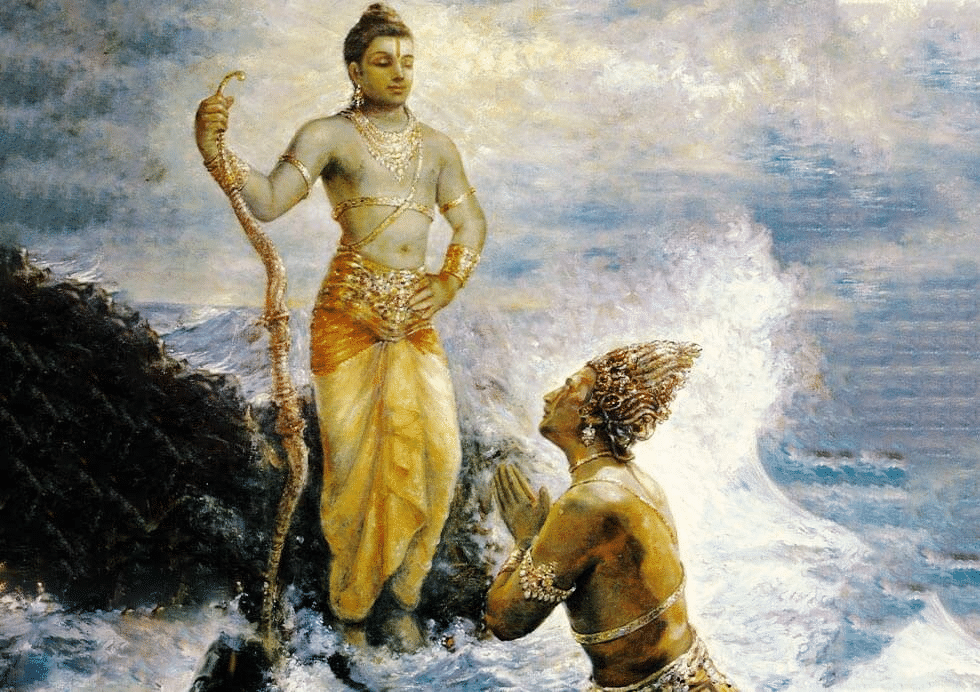
Multiple Choice Questions (MCQs)
Q1: Who is the eldest queen of King Dasaratha?
A) Sumitra
B) Kausalya
C) Kaikeyi
D) None of the above
Ans: B) Kausalya
Kausalya is the eldest queen of King Dasaratha and the mother of Lord Rama.
Q2: Which prince is known for being Rama's loyal companion?
A) Bharata
B) Shatrugna
C) Lakshmana
D) None of the above
Ans: C) Lakshmana
Lakshmana, Lord Rama’s younger brother, is known for being his loyal companion and accompanied him during his exile in the forest.
Q3: How many princes were born to King Dasaratha's queens?
A) Two
B) Three
C) Four
D) Five
Ans: C) Four
King Dasaratha had four sons: Rama, Bharata, Lakshmana, and Shatrugna, born to his three queens—Kausalya, Kaikeyi, and Sumitra.
Q4: Which queen gave birth to Bharata?
A) Kausalya
B) Sumitra
C) Kaikeyi
D) None of the above
Ans: C) Kaikeyi
Kaikeyi, one of King Dasaratha's queens, gave birth to Bharata, the second son of the king.
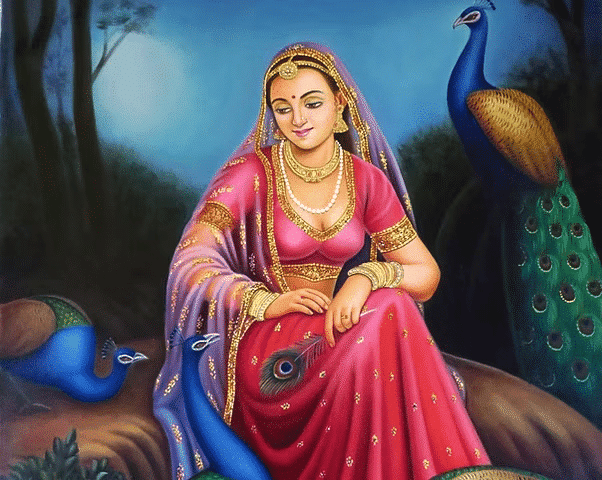
Q5: What was the reaction of the people of Ayodhya to the birth of the princes?
A) They were indifferent
B) They were unhappy
C) They rejoiced
D) They were confused
Ans: C) They rejoiced
The people of Ayodhya celebrated with great joy when the princes were born, as they were eagerly awaiting the birth of heirs to the throne.
Match the following:
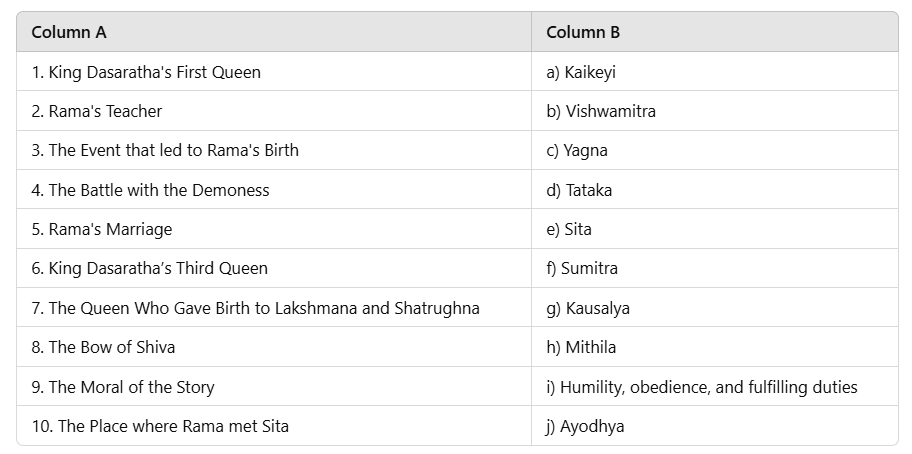
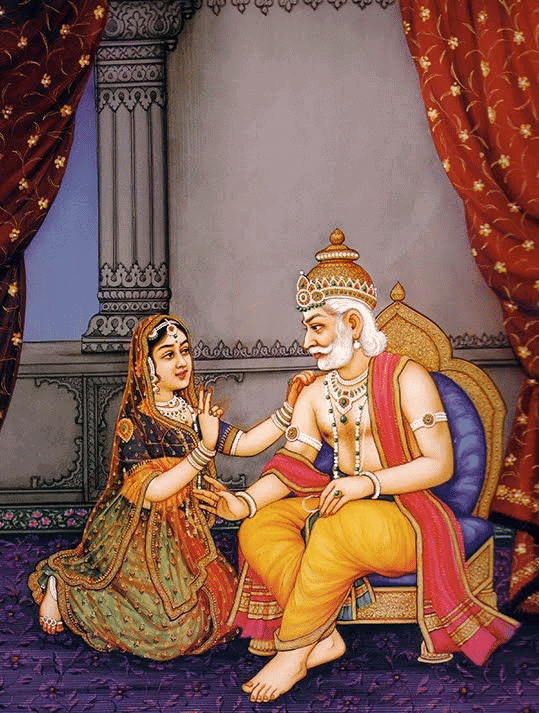
Ans:
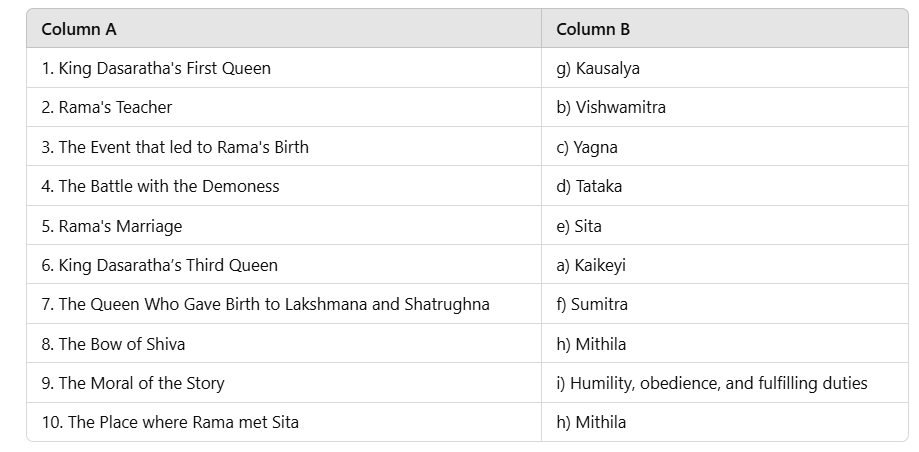
Fill in the Blanks
Q1: Kausalya gave birth to __________, the hero of the Ramayana.
Ans: Rama
Q2: Sumitra is the mother of __________ and Shatrugna.
Ans: Lakshmana
Q3: Kaikeyi is the youngest queen and she gave birth to __________.
Ans: Bharata
Q4: The birth of the princes brought immense joy to the kingdom of __________.
Ans: Ayodhya
Q5: The royal family was filled with happiness and __________.
Ans: Pride
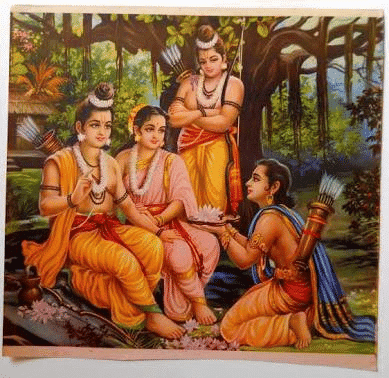
True or False
Q1: Kausalya was the youngest queen of King Dasaratha.
Ans: False
Kausalya was the eldest queen of King Dasaratha, not the youngest. She was the mother of Lord Rama.
Q2: Lakshmana is known for his loyalty to Rama.
Ans: True
Lakshmana is famous for his unwavering loyalty to his brother, Lord Rama, and accompanied him during his exile.
Q3: Bharata and Shatrugna are twins.
Ans: False
Bharata and Shatrugna are not twins. Bharata was the son of Kaikeyi, and Shatrugna was born to Sumitra, and although they were close in age, they were not twins.
Q4: The people of Ayodhya were unhappy about the birth of the princes.
Ans: False
The people of Ayodhya were overjoyed at the birth of the princes, as it was a moment of great celebration and hope for the future of the kingdom.
Q5: The three queens gave birth to four princes.
Ans: True
King Dasaratha had three queens—Kausalya, Kaikeyi, and Sumitra—and they gave birth to four princes: Rama, Bharata, Lakshmana, and Shatrugna.
Odd One-Out Questions
Q1: Kausalya, Sumitra, Kaikeyi, Vishwamitra
Ans: (d) Vishwamitra
Kausalya, Sumitra, and Kaikeyi are King Dasaratha's queens, while Vishwamitra is a sage, not a queen.
Q2: Rama, Lakshmana, Shatrughna, Janaka
Ans: (d) Janaka
Rama, Lakshmana, and Shatrughna are sons of King Dasaratha, while Janaka is the king of Mithila and Sita's father.
Q3: Shiva’s bow, Vishwamitra, Sita, Urmila
Ans: (b) Vishwamitra
Shiva’s bow, Sita, and Urmila are connected to Rama’s story, whereas Vishwamitra is a sage who guides Rama.
Q4: Rama, Bharata, Lakshmana, Tataka
Ans: (d) Tataka
Rama, Bharata, and Lakshmana are key characters in the Ramayana, while Tataka is a demoness defeated by Rama.
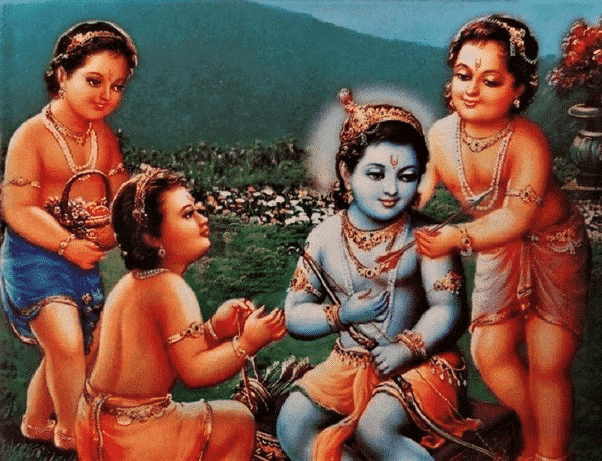
|
18 videos|43 docs|11 tests
|
FAQs on Worksheet Solutions: Introduction to Ramayan - The Legendary Tale of Ramayan: Heroes, Villains, and Divine - Class 6
| 1. What is the significance of Ramayana in Hindu culture? |  |
| 2. Who are the main characters in the Ramayana? |  |
| 3. What lessons can be learned from the Ramayana? |  |
| 4. How is the Ramayana celebrated in modern times? |  |
| 5. What are the different versions of Ramayana across cultures? |  |




















